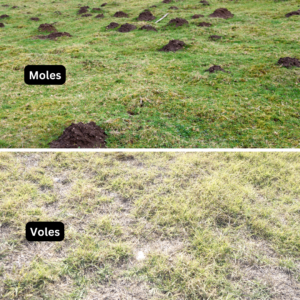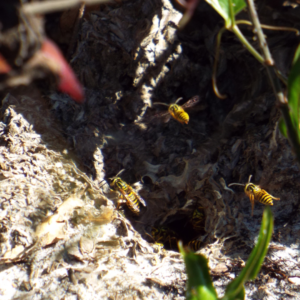- All
- Ants
- Ash Trees
- Centipedes/Moisture Pests
- Fall Insects
- Insect Prevention Plan
- Mice
- Spiders
- Spraying
- Ticks
- Voles and Moles
- Wasps
Wasps build brand new nests every year. This process starts around mid-May or early June. A wasp nest that was built the year before is dead and will never be used again. We recommend scheduling a wasp prevention service at this time to kill any wasps that land on the home before they can build a new nest. This service will not prevent your home from seeing foraging wasps. It’s designed to prevent wasp nests. Wasps will forage around homes with cedar shake roofs, brick & stucco siding, and around wooden decks and fences. Wasps use the wood to make their nest building material. They peel small layers off of dried wood, mix it with their saliva, and use the mixture to construct the papery material their nest are made out of. Homes with brick and stucco siding radiate a lot of heat that will attract wasps to land on the home to warm up their bodies after a cold night. Most wasps will only become violent and sting if an intruder gets too close to their nests. It’s rare for foraging wasps to sting unless they are provoked.
There are a variety of different sprays and products designed to get rid of the ants in your home. Not all the products work the same. A majority of them don’t work at all. The products you should always try to avoid are sprays that are marked to kill the ants instantly, or solving the ant problem quickly. These products have a good chance of making the ant problem worse. The ants inside the home only make up 10% of the entire ant colony. The rest of the ants, including the queen, live underground up to 100 yards away from your home. These products never make it back to the rest of the colony and only kill the ants in your home. This causes the rest of the colony to believe they are under attack and move some ants to another location to start a new nest in a safer area. This is called budding. The products we use take 30 days for them to work. This allows the ants to make their way back to the nest with our product to spread it with the entire colony.
Our warranties include a full 2-year warranty or variations of 2-visit 2-year warranties. Our mouse service warranty is dependent on the limitations found during a mouse inspection. Limitations prevent us from sealing up 100% of the structure. Some examples include; low decks, 3-season porches, foam covering up the foundation, and steep-pitched roofs. If we find any limitations we provide every customer with at least 2 free services for 2 years. These services are only necessary if the customer is still catching mice 30 days after their seal-up is completed. If no limitations are found we offer a full 2-year warranty meaning the customer can call us anytime they are seeing mice for 2 years. Call with any questions regarding renewing a warranty.
Voles and moles can both cause significant damage to a lawn. The key differences are that moles dig underground tunnels while voles eat grass roots and trees and shrubs’ bark above the ground. Earthworms make up close to 90% of a mole’s diet. In the winter moles spend most of their time in their underground den below the frost line and will only start causing lawn damage in the spring and summer, especially after rain. The wet soil forces the worms to start making their way up to the surface and the moles will follow. Voles on the other hand stay active all winter destroying the lawn below the snow. They dig tunnels inside the snow and use leaf litter as a source of insulation.

Dealing with wasp nests can be a tricky and dangerous undertaking. But store-bought wasp killer products often have little effect on one particular kind of wasp nest. If you can’t physically see the wasp nest structure store-bought products will not be effective. This includes ground nests, nests in retaining walls, trees, foundations, etc. The store-bought products will not be able to reach deep enough into the nest to affect the Queen. The only wasps that will be affected are the workers that fly in and out of the nest. Our professional-grade products keep the wasps alive long enough to carry the product deep inside the nest. Once inside it spreads to the entire colony killing the Queen in the process. This can take between 14-30 days depending on the size of the nest.

The cost of an insect prevention plan varies from home to home. The larger the home is the more product we need to use. During each service, we apply a barrier around the home to kill bugs before they get inside or build any nests or webs on the exterior. The quote for the home is the cost of a single service. We schedule 4 services starting in the spring and ending in the fall. We charge for each service individually after they are completed.
Click the link to learn more about our Insect Prevention Plan
No, The bait we place outside around businesses and homes is enclosed inside plastic bait stations and staked to the ground. These stations are used to keep any pets and larger animals from gaining access to the bait inside. On occasion, smaller-sized squirrels and chipmunks may get inside. The mice that eat the bait and die off in nature only ate enough bait to kill a mouse. If another scavenging animal finds the dead mouse that animal would be consuming the same amount of bait which would not be enough to kill anything larger than a mouse. These predator animals also hunt throughout a large territory that expands much farther out than just your house. Your house alone will make up a very small percentage of their overall diet if any at all. Most predator animals would prefer to eat a living animal rather than a cold decomposing mouse carcass.

Mice and voles are both close to being identical in size and shape. Although voles tails are noticeably shorter. The key differences between the two species are mostly in their behavior. Mice are drawn to living inside man-made structures in the winter. Voles prefer to live outside all year and will use leaf litter and snow cover as insulation to keep warm. Mice are nocturnal and voles can be found scurrying around in the yard during all times of the day. They are mostly found living in retaining walls and under thick foliage. Voles eat the roots of blades of grass and bark causing damage to many homeowners’ lawns and plants. Mice prefer to eat seeds and nuts from trees as well as a variety of human and pet food.
No, not every tick carries the Lyme disease bacteria. Ticks only pick up the disease if their host animal has it. Most ticks only live on 3 hosts in their lifetime. If none of the animals they attach themselves to have it then the tick will not pick up the bacteria. It varies by state by how many ticks carry the disease. In Minnesota, the black-legged tick or deer tick is the only tick that carries the bacteria. 1 in 3 adult deer ticks have it and 1 in 5 nymphs. To help identify what a deer tick looks like visit our Tick Page
To learn more about Lyme disease in Minnesota click the link to the Minnesota Department of Health
Carpenter ants do not eat wood to survive like termites. Carpenter ants only chew through wood meaning they never digest it. The wood they chew is moist and soft making it easy for them to chew tunnels and galleries. The wood is often water-damaged or rotting. The narrow tunnels they make are used to store their eggs, larvae, and food. The queen ant and 90% of the worker ants also spend their entire lives inside the wood. Only around 10% of the ants in the colony leave the nest to forage for food. Structural damage caused by carpenter ants is less severe than termite damage. The water seeping into the wood that is attracting the ants will often cause significant structural damage faster than the ants.
Carpenter ants are often misidentified as termites. Termites have rectangular-shaped bodies while carpenter ants’ bodies are unevenly shaped. Comparable to the number 8. Carpenter ants vary between all-black or reddish-black. Termites are lighter in color and are either white or light brown. Winged termites have 4 symmetrical wings that are all the same size while carpenter ant’s wings vary in size with 2 large symmetrical wings and 2 small symmetrical wings. Both insects also have different-sized antennas. Carpenter ant’s antennas are elbowed or bent while termites have short straight antennas. Termites are extremely rare to find in states as far North as Minnesota. If termites are spotted it’s often because they hitchhiked their way from another state.
We provide snap traps for all our customers who decide to move forward with our signature mouse seal-up service. These snap traps will be strategically placed by our technicians inside the home. During this process, we will also demonstrate to all our customers how to operate the traps so that they can be checked and reused to catch more mice. It will take 30 days after the home is sealed to catch the remainder of the mice inside.
Yes! Each of our spider services start with a web knock down around the exterior of the property. But we do have to disclose that we are not a cleaning service! We do not carry power sprayers and can only reach as high as our extension pulls will go (20-25 feet). If a home has a substantial amount of cob webs we would recommend having the home power sprayed first. Our product will then kill all the spiders before they can build any new cob webs.
Read our blog to learn about some of the most common entry points that mice use to get inside! Click Here
The cost of our mouse seal-up service varies from home to home. Each house is built differently than the next. For this reason, it’s impossible to give out an exact price without inspecting the exterior of the home first. Please call us to set up an appointment if you want to learn more.





